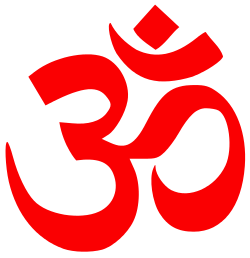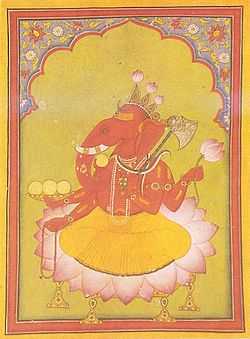Ganapati Atharvashirsa
| Part of a series on |
| Hindu scriptures |
|---|
 |
|
|
Timeline |
The Ganapati Atharvashirsa (Sanskrit: गणपत्यर्थवशीर्ष, Śrī Gaṇapati Atharvaśīrṣa) is a Hindu scripture dedicated to the god Ganesha. It is a late Upanishad that celebrates Ganesha as the ultimate Brahman.[1] The scripture asserts its own status as an upanishad in its final line, which reads "Thus, the Śrī Gaṇapati Atharvaśīrṣa Upanishad"; śrīgaṇapatyatharvaśīrṣopaniṣad).[2] It is also referred to as the Sri Ganapati Atharva Sirsha, the Ganapati Atharvashirsha, the Ganapati Atharvasirsa, or the Ganapati Upanishad.
It is the most widely recited Sanskrit text among devotees of Ganesha in Maharashtra. The entire text is written over the entrance to the temple hall in the aṣṭavināyaka Ganesha shrine at Ranjangaon. Ghurye notes its emergence in the early 19th century, corresponding to the rise of the Ganapati worship in Maharashtra among Brahmins centered in Pune,[3] but the text is probably somewhat older, dating to the 17th or 18th century;[4] it is not part of the Muktikā canon of 108 Upanishads compiled in the mid 17th century, but it was mentioned c. 1800 by Upanishad Brahmayogin in his commentary on the Muktika canon.[5] The text associates itself with the Atharvaveda, in a passage that Chinmayananda translates as "Thus says Atharvana" (Sanskrit:इत्यथर्वणवाक्यम्; ityatharṇavākyam).[6]
Textual variants
As is common with devotional works of this type, variations in the text are often found in manuscripts, which may differ from one another in significant ways. Many of the published works on the Ganapati Atharvashirsa use variant versions of the text, showing differences in content and line numbering, so it is necessary to review multiple editions.
A "critical edition" of a Hindu scripture is a special type of scholarly edition in which many alternative readings from variant manuscripts have been reviewed and reconciled by scholars to produce a consensus text. A critical edition examining variants of the Sanskrit text was published in 1984 by Gudrun Bühnemann with a translation.[7]
A heavily edited and abbreviated translation was made in the early nineteenth century by Vans Kennedy.[8]
J. R. Sartha published a 1969 edition.[9] In 1985 Courtright published an English translation based on the Sartha edition.[10]
Swami Chinmayananda published a variant of the Sanskrit text with an English translation in 1987. In his version of the source text he groups verses together to form sections that he calls upamantras. He notes that as a result of this his line numbering and versification may differ from those given in other variants.[11]
John Grimes provides a structural analysis including a version of the Sanskrit text and an English translation in his 1995 book on Ganapati. His version provides no line numbers.[12]
The text is sometimes found on the Internet in the form of downloadable files or on web sites, but in such cases the reliability and versification of the variants cannot be determined.
Highlights of passages
Ganesha as the supreme deity
In the framework of Ganapatya devotion, Ganesha is regarded as the Supreme Deity, containing all other divine forms within himself. The Ganapati Atharvashirsa declares this in its opening passages as translated by Courtright:
Homage to Lord Gaṇeśa. Oṃ. Reverence to Gaṇapati. You are indeed the visible "That Thou Art" [tattvamasi]. You indeed produce the universe. You indeed sustain it. You indeed destroy it. You indeed are the all pervading reality. You are the manifestation of the eternal self [ātman].[13]
A variant version of this passage is translated by Chinmayananda as follows:
(O Lord Ganapati!) You alone are the visible manifestation of the Essence of the words "That thou art". You alone are the Doer. You alone are the Creator and the Sustainer (of the universe). You alone are the Destroyer. Verily You alone are all this - "idam sarvam" - in the creation, because You are Brahman. You are the Eternal Atman in bodily form."[14]
Identification with other deities and with Om
Ganesha is identifiable with all other deities and with Om. This is celebrated as follows in the Courtright translation:
You are Brahmā, Vişņu, and Rudra [Śiva]. You are Agni, Vāyu, and Sūrya. You are Chandrama. You are earth, space, and heaven. You are the manifestation of the mantra "Oṃ".[15]
A variant version of this passage is translated by Chinmayananda as follows:
(O Lord Ganapati!) You are (the Trinity) Brahma, Viṣnu, and Maheśa. You are Indra. You are fire and air. You are the sun and the moon. You are Brahman. You are (the three worlds) Bhuloka, Antariksha-loka, and Swargaloka. You are Om. (that is to say, You are all this).[16]
Resides in the muladhara chakra
 |
Muladhara Chakra |
Some evidence that the work is of late origin with some Tantric influence is found in a passage which associates Ganapati with the Muladhara chakra. As translated by Courtright this passage reads:
You continually dwell in the sacral plexus at the base of the spine [mūlādhāra chakra].[17]
A variant version of this passage is translated by Chinmayananda as follows:
You have a permanent abode (in every being) at the place called "Muladhara".[18]
Bija mantra
This text provides a detailed description of Ganesha's bija mantra gaṃ (Sanskrit: गं; gaṃ). When this mantra is written using simplified transliteration methods that do not include diacritical marks to represent nasal sounds, it is written as "gam".
This bija mantra is also used in the Ganesha Purana which is generally dated as preceding the Ganapati Atharvasirsa. Courtright translates the passage as follows:
Having uttered the first letter of the word gaṇa, ga, then I utter the nasal sound ṇa which follows and appears beautifully like the crescent moon. This is your form. The ga forms the initial letter, the a forms the middle letter and the ṇa forms the final letter. To utter this sound [i.e., gaṃ] is to utter all sounds together.[19]
A variant version of this passage is translated by Chinmayananda as follows, using Devanāgarī to make the description more clear for those who are familiar with Sanskrit:
One should first utter the first syllable "ग" in the word "गण" followed by "अ" the first of the alphabets. Add an अनुस्वार (a nasal म् indicated by a dot above the line). Then adorn it by a crescent (also a nasal). Prefix ॐ to it. And this represents (O Lord Ganapati!) your terrestrial form endowed with gunas. [20]
References
- ↑ Courtright, Paul B. Gaṇeśa: Lord of Obstacles, Lord of Beginnings. Appendix: "The Śrī Gaṇapati Atharvaśīrṣa". (Oxford University Press: New York, 1985)
- ↑ This is verse 29 in the Chinmayananda variant. Text and verse numbering are given in Chinmayananda (1987) p. 131.
- ↑ Ghurye, G. S. Gods and Men. (Bombay: 1962) pp. 101-2.
- ↑ Courtright (1985) p. 252.
- ↑ Bühnemann, Gudrun. Budha-Kauśika's Rāmarakṣāstotra. Publications of the De Nobili Research Library, vol. 10. (Ed. Gerhard Oberhammer: Vienna, 1983), p. 103.
- ↑ This is verse 21 in the Chinmayananda variant. Chinmayanada notes that his version numbering may differ from that in other variants. Text and verse numbering are given in Chinmayananda (1987) p. 130. Courtright translates the verse as "This text was told by the Atharvan sage." Courtright (1985) p. 254. Chinmayananda comments on this claim of lineage saying that "it may or may not be so", noting that such an attribution of authorship is not found in the body of many of the upanishads. Chinmayananda (1987) p. 122.
- ↑ Bühnemann, Gudrun. Some Remarks on the Structure and Application of Hindu Sanskrit Stotras. Wiener Zeitschrift für die Kunde Südasiens 28, pp. 73-104.
- ↑ Kennedy, Vans. Researches into the Nature and Affinity of Ancient and Hindu Mythology. (London: 1831) pp. 493-94.
- ↑ J. R. Sartha, ed., Śrī Gaṇapati Atharvaśīrṣa. (Bombay, 1969).
- ↑ Courtright (1985) Appendix.
- ↑ Swami Chinmayananda. Glory of Ganesha. (Central Chinmaya Mission Trust: Bombay, 1987). pp. 121-131. Other reprint editions: 1991, 1995.
- ↑ Material on the Atharvaśīrṣa is pp. 21-36 in: Grimes, John A. Ganapati: Song of the Self. (State University of New York Press: Albany, 1995) ISBN 0-7914-2440-5 In his notes Grimes cites the Courtright and Chinmayananda editions, as well as Navaratnam, Aum Gaṇeśa, 101-18.
- ↑ Translation by Courtright (1985) p. 253
- ↑ Chinmayananda (1985) p. 125. In Chinmayananda's numbering system this is upamantra 1.
- ↑ Translation by Courtright (1985) p. 253
- ↑ Chinmayananda (1987) p. 127. In Chinmayananda's numbering system this is upamantra 8.
- ↑ Translation by Courtright (1985) p. 253
- ↑ Chinmayananda (1987) p. 127. In Chinmayananda's numbering system this is part of upamantra 7.
- ↑ Translation by Courtright (1985) p. 253
- ↑ Chinmayananda (1987) p. 127. In Chinmayananda's numbering system this is part of upamantra 9.
Further reading
- Swami Chinmayananda. Glory of Ganesha. (Central Chinmaya Mission Trust: Bombay, 1987). pp. 121-131. Other reprint editions: 1991, 1995.
- Courtright, Paul B. Gaṇeśa: Lord of Obstacles, Lord of Beginnings. Appendix: "The Śrī Gaṇapati Atharvaśīrṣa". (Oxford University Press: New York, 1985) ISBN 0-19-505742-2
- Grimes, John A. Ganapati: Song of the Self. (State University of New York Press: Albany, 1995) ISBN 0-7914-2440-5
- P.K Virkar, Y.S Kulkarni. Stories of Ganesha. (Anmol Prakashan: Pune 2002) pp. 104-123
External links
| ||||||||||||||||||||||||||||
